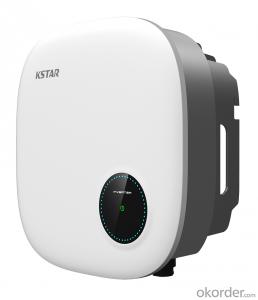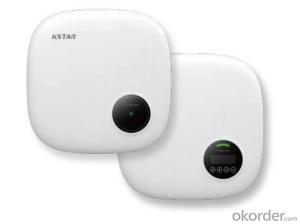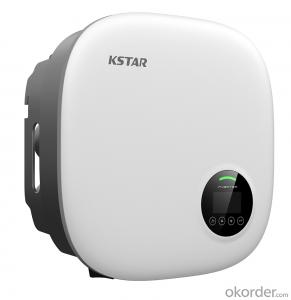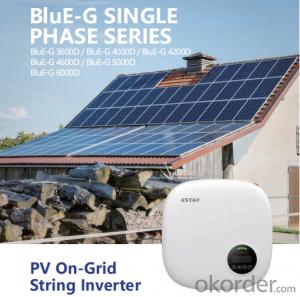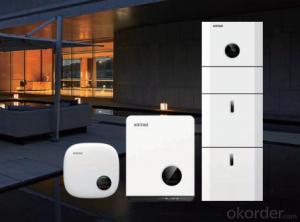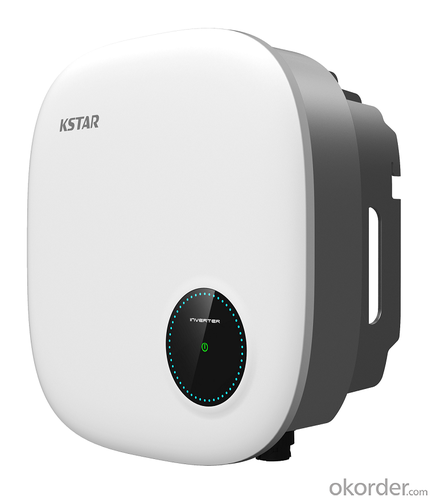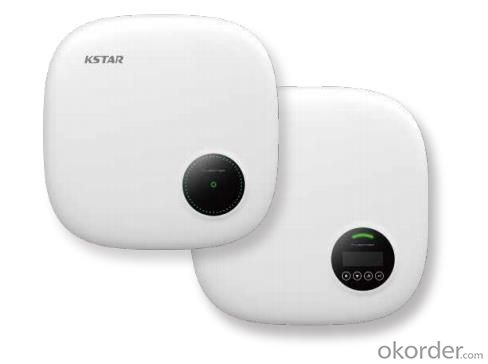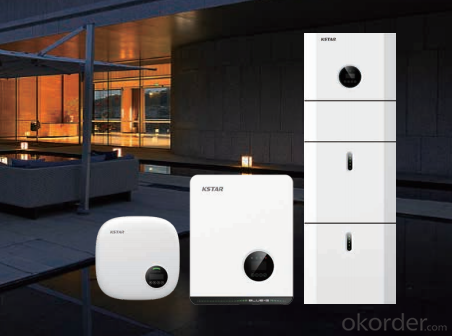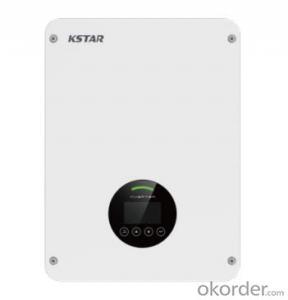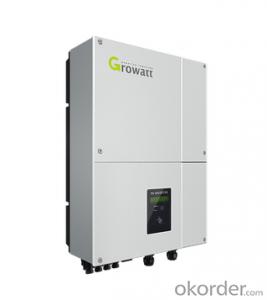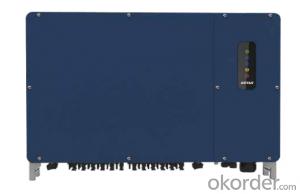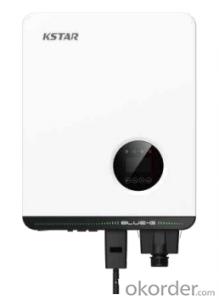Tata Solar Inverter String Grid-Tied PV Inverter Blue-G 3000D / 3600D / 4000D / 4200D / 4600D / 5000D / 6000D
- Loading Port:
- China main port
- Payment Terms:
- TT OR LC
- Min Order Qty:
- 50 pc
- Supply Capability:
- 15000 pc/month
OKorder Service Pledge
OKorder Financial Service
You Might Also Like
Specification
KSTAR BluE Power Your Green Life
Product Description:
★Max. PV voltage up to 600V DC/AC ratio up to 1.5
★Type II DC SPD/Type III AC SPD IP65 protection
★High efficiency up to 98.3% Smaller and lighter
★Compatible for big capacity PV panel WiFi / 4G Plug optional
One Stop Solution Compatible with any type of Demand
Our BluE series covers single phase 1 to 6kw, three phase 3-25kw and up to 20kwh Energy Storage System. This range is predominantly designed for modern house and small commericial energy demands.
One App to monitor your power flow for different systems;
One Call for pre-sales training & after-sales service;
Technical Specifications:
| MODEL | BluE-G 3000D | BluE-G 3600D | BluE-G 4000D | BluE-G 4200D | BluE-G 4600D | BluE-G 5000D | BluE-G 6000D |
| Input(DC) | |||||||
| Max. DC Voltage | 600Vdc | 600Vdc | 600Vdc | 600Vdc | 600Vdc | 600Vdc | 600Vdc |
| Nominal Voltage | 380Vdc | 380Vdc | 380Vdc | 380Vdc | 380Vdc | 380Vdc | 380Vdc |
| Start Voltage | 100V | 100V | 100V | 100V | 100V | 100V | 100V |
| MPPT Voltage Range | 80V-560V | 80V-560V | 80V-560V | 80V-560V | 80V-560V | 80V-560V | 80V-560V |
| Number of MPP Tracker | 2 | 2 | 2 | 2 | 2 | 2 | 2 |
| Strings Per MPP Tracker | 1 | 1 | 1 | 1 | 1 | 1 | 1 |
| Max. Input Current Per MPPT | 15A | 15A | 15A | 15A | 15A | 15A | 15A |
| Max. short-circuit Current Per MPPT | 18A | 18A | 18A | 18A | 18A | 18A | 18A |
| Output(AC) | |||||||
| Nominal AC Output Power | 3000W | 3600W | 4000W | 4200W | 4600W | 4600W | 4600W |
| Max. AC Apparent Power | 3000VA | 3960VA | 4400VA | 4620VA | 5060VA | 5500VA | 6000VA |
| Nominal AC Voltage | 230V L-N | 230V L-N | 230V L-N | 230V L-N | 230V L-N | 230V L-N | 230V L-N |
| AC Grid Frequency Range | 50Hz / 60Hz±5Hz | 50Hz / 60Hz±5Hz | 50Hz / 60Hz±5Hz | 50Hz / 60Hz±5Hz | 50Hz / 60Hz±5Hz | 50Hz / 60Hz±5Hz | 50Hz / 60Hz±5Hz |
| Max. Output Current | 14.4A | 17A | 19A | 20A | 22A | 24A | 26A |
| Power Factor (cosφ) | 0.8 leading to 0.8 lagging | ||||||
| THDi | <3%< td=""> | ||||||
| Efficiency | |||||||
| Max. Efficiency | 98.10% | 98.10% | 98.30% | 98.30% | 98.30% | 98.30% | 98.30% |
| Euro Efficiency | 97.70% | 97.70% | 97.90% | 97.90% | 97.90% | 97.90% | 97.90% |
| Protection devices | |||||||
| DC switch | Yes | Yes | Yes | Yes | Yes | Yes | Yes |
| Anti-islanding Protection | Yes | Yes | Yes | Yes | Yes | Yes | Yes |
| Output Over Current | Yes | Yes | Yes | Yes | Yes | Yes | Yes |
| DC Reverse Polarity Protection | Yes | Yes | Yes | Yes | Yes | Yes | Yes |
| String Fault Detection | Yes | Yes | Yes | Yes | Yes | Yes | Yes |
| Surge Protection | DC Type III;AC Type III | ||||||
| Insulation Detection | Yes | Yes | Yes | Yes | Yes | Yes | Yes |
| AC Short Circuit Protection | Yes | Yes | Yes | Yes | Yes | Yes | Yes |
| General Specifications | |||||||
| Dimensions W x H x D | 380*380*150mm | ||||||
| Weight | 10kg | 10kg | 11kg | 11kg | 11kg | 11kg | 11kg |
| Operating Temperature Range | –25℃~+60℃ | ||||||
| Cooling Type | Natural | ||||||
| Max. Operation Altitude | ≤4000m | ||||||
| Max. Operation Humidity | 0-100% | ||||||
| AC Output Terminal Type | Quick Connector | ||||||
| IP Class | IP65 | ||||||
| Topology | Transformer-less | ||||||
| Communication Interface | RS485/WIFI/4G | ||||||
| Display | LCD | ||||||
| Certification & Standard | EN/IEC62109-1/2;IEC/EN61000-6-2;IEC/EN61000-6-4;IEC61683;IEC60068;IEC60529;IEC62116; IEC61727;EN50549-1;AS 4777.2;NRS 097;VDE-AR-N-4105;VDE 0126-1-1;CEI0-21;G98;G99;C10/C11;TED749; UNE217001;UNE217002;NB/T32004-2018;GB/T19964-2012;INMETRO | ||||||
Q:How the output voltage of the PV inverter and the grid-connected voltage are determined
Inverter is the DC power (battery, battery) into alternating current (usually 220V, 50Hz sine wave). It consists of inverter bridge, control logic and filter circuit. Widely used in air conditioning, home theater, electric wheel, power tools, sewing machines, DVD, VCD, computer, TV, washing machine, range hood, refrigerator, video recorders, massage, fan, lighting and so on. In foreign countries
Q:Installation and maintenance of photovoltaic grid - connected inverter
only when the local power sector permission by the professional and technical personnel to complete all the electrical connection before the inverter can be connected.
Q:What is the difference between a PV grid-connected inverter and an off-grid inverter?
Off-grid inverter is equivalent to their own to establish an independent small power grid, mainly to control their own voltage, is a voltage source.
Q:After the PV inverter, how to achieve the same period before the network?
Solar panel simulator: with MPPT function, simulated morning, noon, afternoon, evening, rainy weather, solar panels produced under different conditions in different voltages.
Q:Is the PV inverter a current source or a voltage source?
According to the waveform modulation method can be divided into square wave inverter, stepped wave inverter, sine wave inverter and modular three-phase inverter.
Q:Photovoltaic grid-connected inverter without DC emc how will happen
Solar photovoltaic power generation technology is the use of solar cells, the photovoltaic effect of semiconductor materials, solar radiation can be directly converted into a new type of power generation system, solar energy is a radiant energy, solar power means --- to direct conversion of sunlight Into electricity,
Q:What is the difference between low voltage grid connection and medium voltage grid connection?
For photovoltaic power plants when the power system accidents or disturbances caused by photovoltaic power plant grid voltage drop, in a certain voltage drop range and time interval, the photovoltaic power plant can ensure that non-off-line continuous operation.
Q:Is the grid side of the grid and the inverter?
The grid load side of the grid is the grid. The inverter is an important part of the PV grid-connected system and can not be regarded as an external load. Photovoltaic power generation system is included in both grid and off-grid.
Q:PV grid-connected inverter and independent inverter in the control of what is the difference
The independent inverter in the output voltage phase amplitude of the frequency control is initially set good. Independent inverter, you should refer to off-grid inverter, do not need to consider the grid situation.
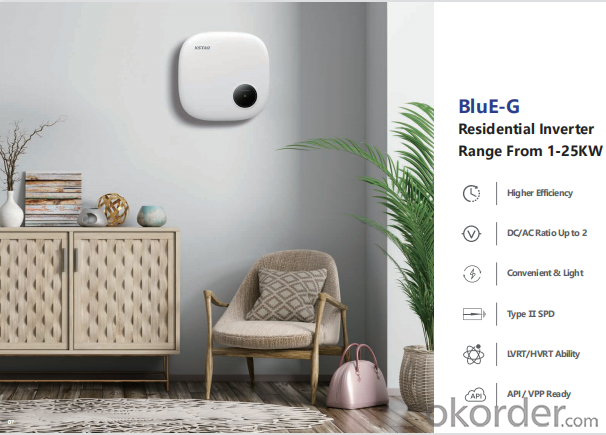
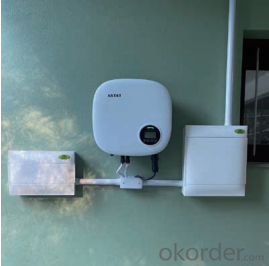

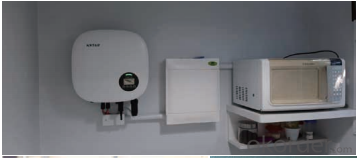

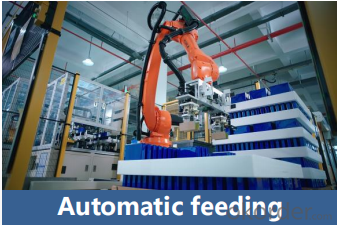
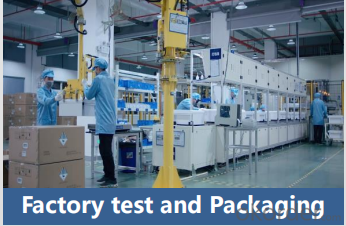

- Q: Can a solar inverter be used in grid-tied systems?
- Yes, a solar inverter can be used in grid-tied systems. In fact, a grid-tied system requires a solar inverter to convert the DC power generated by the solar panels into AC power that can be fed into the electrical grid. The solar inverter also ensures that the system synchronizes with the grid and complies with safety regulations.
- Q: How does a solar inverter convert DC power to AC power?
- A solar inverter converts DC power to AC power by using a two-step process. Firstly, it takes the direct current (DC) electricity generated by the solar panels and converts it into alternating current (AC) electricity. This is done by using electronic components, such as transistors and capacitors, to mimic the characteristics of AC electricity. Secondly, the inverter adjusts the converted AC power to match the desired voltage and frequency of the electrical grid, ensuring compatibility with the appliances and devices that will use the electricity.
- Q: Can a solar inverter be used with building-integrated photovoltaic systems?
- Yes, a solar inverter can be used with building-integrated photovoltaic (BIPV) systems. Solar inverters are an essential component of any photovoltaic system, including BIPV systems. They are responsible for converting the direct current (DC) generated by the solar panels into alternating current (AC) that can be used to power electrical devices in buildings. Therefore, a solar inverter is necessary to ensure the seamless integration of BIPV systems with the electrical grid and the effective utilization of solar energy.
- Q: How do you calculate the payback period for a solar inverter?
- To calculate the payback period for a solar inverter, you need to determine the initial cost of the inverter and then calculate the annual savings or earnings generated by the inverter. Divide the initial cost by the annual savings to get the payback period, which is the time it takes to recoup the investment through savings or earnings.
- Q: How does a solar inverter handle voltage regulation during sudden load changes?
- A solar inverter handles voltage regulation during sudden load changes by continuously monitoring the grid frequency and voltage. When there is a sudden load change, the inverter adjusts its power output accordingly to maintain a stable voltage level. It does this by dynamically controlling the power conversion process, regulating the flow of electricity from the solar panels to the grid. This ensures that the voltage remains within the acceptable range even during sudden changes in load demand.
- Q: What is the maximum AC current output of a solar inverter?
- The maximum AC current output of a solar inverter depends on its size and rating. It can range from a few amps to several hundred amps, typically ranging between 5-100 amps for residential inverters and going up to higher currents for commercial or utility-scale inverters.
- Q: How does a solar inverter handle voltage sags and swells?
- A solar inverter handles voltage sags and swells by continuously monitoring the input voltage. When it detects a sag or swell, it adjusts its internal voltage control mechanism to compensate for the variation. This ensures that the output voltage from the inverter remains stable and within the desired range, protecting the connected solar panels and electrical systems from potential damage.
- Q: Can a solar inverter be used in extreme weather conditions?
- Yes, solar inverters are designed to withstand a wide range of weather conditions, including extreme heat, cold, humidity, and even harsh environmental factors. They are built to be durable and reliable, ensuring their functionality and performance in various climates and weather conditions.
- Q: Are solar inverters compatible with smart home systems?
- Yes, solar inverters are compatible with smart home systems. In fact, many modern solar inverters are designed to integrate seamlessly with smart home technology, allowing homeowners to monitor and control their solar energy production and consumption through their smart devices. This integration enables better energy management, increased efficiency, and the ability to optimize the use of solar power within a smart home ecosystem.
- Q: Can a solar inverter be used with solar-powered ventilation systems?
- Yes, a solar inverter can be used with solar-powered ventilation systems. A solar inverter is responsible for converting the direct current (DC) electricity generated by solar panels into alternating current (AC) electricity that can be used to power various appliances and devices, including ventilation systems. By connecting the solar panels to the solar inverter, the DC electricity produced by the panels can be converted into the appropriate AC voltage and frequency required for the ventilation system's operation. Thus, the solar inverter plays a crucial role in enabling the integration of solar power into ventilation systems.
Send your message to us
Tata Solar Inverter String Grid-Tied PV Inverter Blue-G 3000D / 3600D / 4000D / 4200D / 4600D / 5000D / 6000D
- Loading Port:
- China main port
- Payment Terms:
- TT OR LC
- Min Order Qty:
- 50 pc
- Supply Capability:
- 15000 pc/month
OKorder Service Pledge
OKorder Financial Service
Similar products
Hot products
Hot Searches
Related keywords
